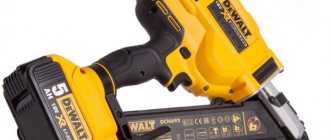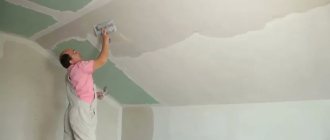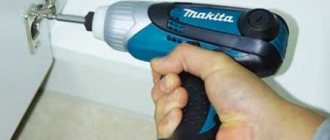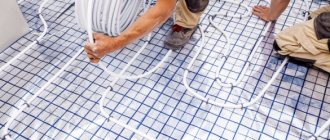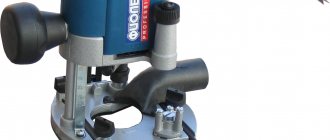| Place | Name | Characteristics in the rating |
| TOP 10 best profile cutters |
| 1 | BISON “MASTER” | The best tool steel |
| 2 | SIBIN 313 | A simple tool at an attractive price |
| 3 | Matrix 87951 | High quality lever system |
| 4 | DEXX 31391 | Best price |
| 5 | STAYER "GRAND" | The most reliable design |
| 6 | Enkor 300mm | Strengthened system |
| 7 | Sibin | A cutter with an enlarged mouth |
| 8 | Bison 3135 | The most convenient one-handed model |
| 9 | Brigadier | Presence of a rotating head |
| 10 | Knipex KN-9042250 | The best choice |
A cutter is a tool that allows you to quickly connect metal profiles to each other without using additional fasteners. The principle of its operation is to punch holes at the joints and simultaneously roll the edges. Thanks to this technique, we get a durable structure for drywall, and the main advantage of such fastening is the speed of construction.
When choosing a cutter for a profile, you should pay attention to the following factors:
- steel quality;
- reliability of the mechanism;
- ergonomics of handles;
- the presence of a lever mechanism, or its absence;
- punch size.
Most aspects are easy to determine by eye, except for the build quality and the steel used. You can’t do this without personal experience or reviews from real users. We also studied them and took them into account when compiling our rating, which included the 10 best models with which you will not experience any inconvenience when working. The TOP included both the most popular manufacturers, who often inflate the price just for their name, and little-known brands from Asia, which are also distinguished by their high quality and compliance with all stated requirements. We will look at both cutters with a reinforced punch and the simplest lever-type tools, which cost less, but are less convenient during operation and force the master to exert increased effort when pressing the levers.
The best hand models
Let's look at several current models of hand tools.
Sparta
A simple and inexpensive, but very convenient tool. Made of durable stainless steel coated with anti-corrosion coating. The handles have polymer pads that prevent slipping and improve grip. Designed for connecting metal profiles up to 1-1.2 mm thick.
Thanks to the small diameter of the bracket, it is quite maneuverable and easily allows you to connect the profile even in hard-to-reach places.
The average cost of the model in Russian stores is 500-600 rubles.
SIBIN 3132
Inexpensive cutter. Structurally, it is almost no different from Sparta, but has a larger diameter bracket and is a little more massive. Thanks to this, the model can be used to work with profiles up to 1.5 mm thick.
The average cost in Russian stores is in the range from 700 to 800 rubles.
DEXX 31391
An inexpensive but high-quality cutter that can be purchased for 500-600 rubles. It stands out among other budget devices due to its high-quality assembly. Capable of working with metal profiles up to 1 mm thick.
Electrical
Becornce F30
The electric furniture stapler Becornce F30 operates at a voltage of 220 V. The tool is designed for driving staples measuring 10-30 mm at a speed of 45 pcs/min. The body of the staple gun is made of bright orange plastic, the working surface is made of aluminum. The handle has an ergonomic shape that is comfortable to grip with your hand; on the front there is a power button and trigger. To drive a staple, you will need to turn on the stapler and lightly press the trigger. The dimensions of the device are 22x22cm. The power of the staple gun is 2300 W. This is enough to pierce hardwood with staples.
DEKO DKET01
The DEKO DKET01 electric furniture stapler works with staples and nails. The tool is quite impressive in size - 27.5x7x19.5 cm, weighing about one and a half kg, made of durable orange plastic with black rubberized inserts on the handle and body. The magazine is made of aluminum, where staples and nails are easily inserted in just one movement. The staple gun operates on a 220 V network, the cable length is 2 meters. The power button and driving depth adjustment are located at the bottom of the housing. There is a trigger on the handle. The staple gun is suitable for both the home craftsman and professional construction or furniture work.
DEKO DKET02
Electric powerful furniture stapler DEKO DKET02 is designed for driving staples and nails into wooden surfaces, plastic, chipboard and MDF boards, plywood. The staple gun operates from a 220V electrical network, the wire length is 2 m. The tool has quite impressive dimensions - 28x27x8 cm and weighs more than 2 kg. Hammering speed is 20 staples per minute. At the bottom of the case there is a power button, on the side there is a shock force regulator. The trigger is located on the handle. The staple gun is made of black plastic with yellow rubberized inserts on the handle and body to reduce slipping.
TASP MESG45
The electric furniture stapler TASP MESG45 is small in size 14.5x17 cm, weighs only 600g and can be used even by women. Using a staple gun you can drive staples 8-14mm and nails 15mm high. The kit, along with the stapler, includes a set of 800 staples and 200 nails. The tool is made of durable plastic in sky blue color. The handle and part of the body are lined with rubberized anti-slip inserts. The staple gun operates from a 220 volt network, the cord length is 2 m. The number of blows is 30 per minute, which is quite enough for professionals. The handle is ergonomically shaped, easy to grip, there is a start button in front, and a lock on the side.
Prostormer PTET1054
The electric furniture stapler Prostormer PTET1054 is made of blue plastic with black rubber inserts. The device runs on electricity, the cord is 2 meters long. The staple gun is designed for automatically driving staples (8-16mm) and nails (15-16mm) into wood, plastic, plasterboard, chipboard sheets. The power button and power regulator are located at the bottom of the case. The tool is capable of hammering consumables at a speed of up to 20 per minute. The rated power of the device is 2000 W. The kit includes a set of staples and nails for testing the staple gun in operation.
HIMOSKWA YWL124TE
The electric furniture stapler HIMOSKWA YWL124TE is designed for driving staples and nails at a speed of up to 30 per minute. Power - 2000W. For the staple gun to work, it must be connected to a 220 V electrical network. When choosing a modification of the tool, you should pay attention to the type of plug suitable for the region. The body is made of durable light green plastic. Ergonomic handle with rubber pads for comfortable grip. The magazine and working area of the stapler are made of aluminum. The power button on the staple gun is located at the bottom of the body, and the trigger is conveniently placed on the handle.
HIFESON F30/422
Electric furniture stapler HIFESON F30/422 is designed for fastening various materials with staples (6-22mm) or nails (6-30mm). The staple gun operates from a 220V electrical network. When ordering a stapler, you should pay attention to the design of the plug, which is manufactured according to European or American standards. The dimensions of the staple gun are 230x240 mm. It is made of burgundy plastic. The handle has a power button and a trigger. The upper part is oblong shaped for gripping with the second hand. The magazine is made of aluminum and refilling with consumables is easy.
Dutoofree F3042
The Dutoofree F3042 electric furniture stapler with a power of 2000 W has 6 impact force modes and operates on a 220V power supply. Suitable for fastening various materials with nails 15-30mm and staples 15-25mm long. The body of the staple gun is made of plastic with motor cooling holes, which protects the device from overheating. Ergonomically shaped handle with trigger. The magazine is made of aluminum and can be filled with consumables in just one movement. The staple gun can be used for home work, and it will also be a good assistant for a professional craftsman.
DOERSUPP
The DOERSUPP electric furniture stapler with a power of 1800 W fastens even hard materials with staples up to 30 mm in length and nails 10-30 mm. Driving speed is 1-3 nails per second. The tool operates from a mains voltage of 220-240V, to which it is connected using a Euro plug with a two-meter cord. The staple gun is suitable for household needs and professional work. The comfortable, ergonomically designed handle is comfortable to hold in your hand. At the bottom of the handle there is a power button, at the top there is a trigger. The staple gun is made of plastic, the magazine is made of durable aluminum alloy. Dimensions 20x23 cm, weight 2 kg.
Drillpro
The Drillpro electric furniture stapler with a rated power of 2000 W is made of durable plastic with a rubber grip on the handle. The stapler operates from a 220-240 V electrical network. It is connected using a Euro plug, the cord length is 2 meters. Small in size - 22x22 cm, the staple gun is powerful enough for professional work with hardwood. The stapler can be used to drive straight staples and nails up to 30mm long at a speed of 30 per minute, which is one of the best performance among staple guns.
What is a cutter
A cutter is a hand-held tool that is used in installation work to connect metal profiles into frames, as well as for fixing sheet products.
This technology involves making holes in materials superimposed on each other. In this case, the ends of the holes on the reverse side are formed with rolling, which ensures a strong connection.
The area of use of the cutter began to expand rapidly after the spread of profile systems for plasterboard in repair and construction work.
The formal purpose of the tool is to quickly install metal frames of suspended ceilings and plasterboard partitions.
The design of the cutter is quite simple, including several elements:
- a movable handle connected to a lever and a punch;
- a bracket having two legs and a stop with a recess;
- fixed handle fixed to the bracket.
For convenient storage of the tool in a suspended position, a loop is provided. The movement of working elements is carried out using movable axes.
The operating principle of different types of cutters remains unchanged:
- the operator applies force to the movable lever;
- translational movements of the punch are formed;
- The punch, resting against the profile, makes holes in its plane until it stops.
The edges of the holes are bent, thanks to which it is possible to create a reliable and durable connection.
The degree of impact on the tool depends on the force applied. The punch easily passes through the entire thickness of the plasterboard sheet due to the length of the lever and additional attachment mechanisms.
How to use the cutter
Installation work can be completed efficiently by adhering to the following rules for using pliers.
How to fasten a ceiling profile (PP) with a guide profile (PPN) using a conventional cutter
- You should start by checking the functionality of the tool. To do this, it is suggested to make several test connections. Based on the nature of the passage of working elements into the plane of the profiles and the quality of the holes, appropriate conclusions are drawn.
- The next step is to check the strength of the connections. Under the influence of forces, the reliability of the frame is controlled. A negative result may indicate low quality of the metal from which the profiles are made. In this case, it is better to make connections with self-tapping screws or replace weak material. Professional flaring does not guarantee a long service life of the frame structure when connected with a cutter.
- Installation work begins with installing the profile. To do this, make markings by placing two parts overlapping.
- The junction is grabbed with pliers. Next, the steel sheet is slightly split.
- The junction of the steel elements is fixed by squeezing the handle. The grip is weakened when using a mechanism with a return spring.
- After releasing the tool, check the strength of the connection.
The quality of the equipment directly influences the result of the connection. If, after fixing the joint, the antennae do not unbend completely, the problem lies in the pliers themselves. When working with a professional device, you should focus on the grip strength of the handle. Heavy pushing is often caused by insufficient impact, so the attempt should simply be repeated (passing through the same holes).
Is it possible to fasten plastic panels to drywall with furniture staples?
Liquid nail is just right!
But it will take more time! Staple clips definitely won't work! You smear liquid nails on the dots and, so as not to hold the panel, screw the panel shelf with self-tapping screws. Other answers
Can. will soon fall off. panels. Of course you can't.
I don't think it's humane
Armenian radio asks: Is it possible to swallow billiard balls? - We answer! -YES ! if you have a steel toilet. (anecdote on the topic)
It is possible for temporary fixation - if the panel is glued with liquid and nails to the gypsum plasterboard wall. Isn’t it easier to use a self-tapping screw through the plasterboard into the frame? This will be even more reliable than shooting with a stapler
it will be like “on the snot”, this is also to hold tightly, take the thinnest panel - 5-piece, and the longest brackets. and then, it will be best to screw it “on the snot” with bugs or glue it with liquid nails.
The best professional tool
Below are some current professional tools.
BISON Master 3135
A domestically produced tool, the cost of which is only 1,500 rubles. It has a massive bracket, reinforced with additional steel strips. Equipped with a specially designed lever. Thanks to this, it is possible to penetrate a thick profile.
Brigadier
An inexpensive cutter with a powerful bracket, designed to work with thick profiles. Structurally reminiscent of the Bison. But it costs slightly less – about 1,100 rubles.
TOPEX (43E101)
Model with a reinforced bracket made of two steel plates connected by rivets. Thanks to this design solution, it is able to penetrate even thick metal profiles. Designed for one-handed operation. It has a rather tight return spring, so not everyone will be comfortable working with the device.
The average cost of the model is 2,000-2,500 rubles.
Advantages
Installation of drywall profiles using a cutter differs from the classic method using self-tapping screws. Ticks have significant advantages:
- Significant savings for large volumes.
- Energy independence. The tool can be used anywhere. Its action is purely mechanical.
- No need to make markings.
- Profiles are not subject to deformation.
- The holes are neat, with smooth edges.
- No additional tools (drill, screwdriver) are required to carry out the work.
- There will be no dents left on the frame.
With the help of a cutter, a hole is punched faster than a self-tapping screw is screwed in, and there is no risk that it will go far. Thanks to the profile pliers, the connections are reliable. If necessary, they can be easily disassembled.
Is it possible to attach a profile for installing a partition to drywall?
The fact is that the attic floor is already covered with plasterboard, but there are no partitions. It is unlikely that you will be able to guess where the logs are, and everything has already been puttied. Will the profile structure itself, and subsequently the partition itself, hold up if I screw the profiles into the main body? Or will you still have to dismantle the walls and ceiling?
Vote for best answer
correctly through the drywall into the profile (rail). Determine where the partition will be, remember the direction of the old frame, if the plaster is putty, try using a small magnet to look for screws
If the ceiling was assembled on a profile (rarely on bars), then with a neodymium magnet you can quickly find it. If no profiles are found along the line of the future partition, then the guide can be fastened to the drywall with long self-tapping screws so that they reach the wooden sheathing.
The screws must be attracted to the profile; they will not stick to the gypsum board. Look for the profiles under the sheets and twist the starting profile of the new partition into them.
this won't last. look for the profile, the pitch is usually 60cm, touch the putty - maybe you will feel the screws. drill a few thin holes - then cover it up...

